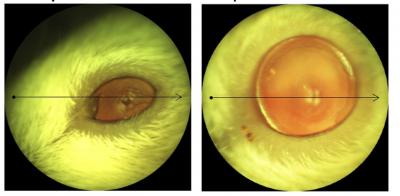
Representative eye of a PAX6 deficient mouse after treatment (right) showing a better developed eye and clear cornea compared to a control treated PAX6 deficient mouse eye (left) showing a smaller eye with scarring and blood vessel growth. Image credit: University of Illinois Chicago.
Researchers at the University of Illinois Chicago have published a study showing a promising approach to using drug repurposing to treat genetic diseases.
A team from the UIC Department of Ophthalmology and Visual Sciences published the article, “Gene dosage manipulation alleviates manifestations of hereditary PAX6 haploinsufficiency in mice” in the journal Science Translational Medicine.
Researchers used a mouse model of the human disease aniridia, an eye disorder that affects the iris and causes substantial visual impairment and can also be associated with systemic abnormalities. In aniridia, one copy of the gene PAX6 is normal and the other copy is non-functional.
The investigators screened drugs that can enhance PAX6 and found a particular class of drugs known as MEK inhibitors can stimulate PAX6 expression in the eye.